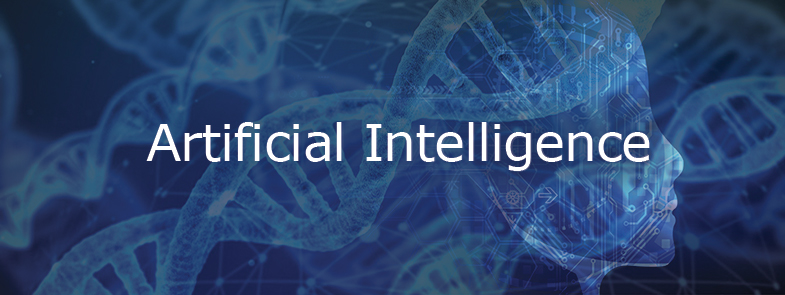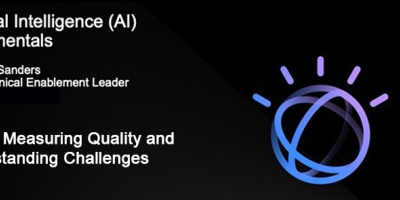Artificial intelligence (AI) has the potential to radically advance medicine and healthcare, reduce sickness, eradicate diseases, and accelerate recovery times. From intelligent prosthetics to cellular manipulation, AI can help humanity live healthier and longer.
When I look back at historical movies involving medical procedures or the ways wounded soldiers were operated on by medics in field hospitals, I often think “how barbaric” compared to the healthcare we receive today. I then wonder if future generations might look back at us and arrive at similar conclusions.
Smarter Healthcare
Artificial intelligence (AI) is being used to look at diseases and viruses to help better predict trends and outcomes with degrees of confidence, along with what prescriptive actions to take. The potential to learn about disease and illnesses down to the cellular level could help prevent and manage sickness, and design and deliver intelligent forms of vaccines and treatments that deliver better results, with less side effects, in less invasive ways.
Take for instance Watson for Oncology. It combines leading oncologists’ deep expertise in cancer care with the speed of IBM Watson to help clinicians as they consider individualized potential cancer treatment options for their patients. Watson for Oncology is a solution that is fueled by information from relevant guidelines, best practices, and medical journals and textbooks. The solution assesses information from a patient’s medical record and displays potential treatment options ranked by level of confidence based on training with supporting evidence. The oncologists can then apply their own expertise to identify the most appropriate treatment options. Considering the thousands of papers and journals written by the medical professionals across the world in different languages, it is doubtful that any single clinician can read everything ever written on cancer and absorb all that data in its different contexts. Watson can consume and keep pace with the growing body of medical literature, guidelines, trials, articles, and patient data. It can “understand” the longitudinal medical record and apply natural language processing and advanced cognitive algorithms to each unique patient case. From that, it can generate a list of potential treatment options ranked by applicability—recommended, for consideration, and not recommended. And it can review treatment options and supporting evidence side by side and quickly access the relevant articles and clinical data.
Out on a Limb
Amputees are often faced with many challenges. Take for example, a dancer who loses a leg. You might think that person would never be able to dance again. However, prosthetic limbs can already interface a human’s nervous system by sensing and responding to movements, and become progressively smarter. Mind-controlled prosthetics with sensory feedback are becoming reality, to the point they become an extension to the body. Think of wiggling your toes or your finger—and it just happens. Work is being done on robotic arms that have “load cells” in the fingertips to detect force and torque at each joint. Sensors give feedback on temperature and vibration and collect the data to mimic what the human arm is able to detect. The prosthetic can apparently respond to thought much like a normal arm. Taking this one step further, we could ask ourselves, why should we be constrained by the physical limitations of our own bodies? It is not inconceivable that there might come a time when AI-based bodily augmentation becomes the norm, maybe resulting new kinds of sports. Maybe humankind will one day look down on those of us who don’t have bodily augmentation, creating a new class system.
Smart Medical Devices
Sometimes we might forget to take our medicine on time. Or it just might be inconvenient to do so. Think of the rapidly increasing number of people who have diabetes. Some people may need to take tablets at certain times of the day. Others need to test their blood sugar and, depending on the range, inject a set amount of insulin into the body. Intelligent wearable devices could automatically test the blood sugar level at regular intervals and inject or release insulin and other drugs when needed, being aware of the patient’s current actions, environment, location. The device could report the actions and results back to clinicians in real time, all without any human interaction. If the AI detects an anomaly, it could notify the patient or clinician directly via a cell phone or smart watch. Diabetes is just one example. There might also be many other diseases that could be better managed in this way.
Cellular-Level AI
For many years, scientists have studied how cells behave, their movement, how they attack or attach to other cells. Cells contain data and state. Much work has been done to unravel the mysteries of DNA. In its basic form, it is a molecule composed of two chains that coil around each other to form a double helix carrying genetic instructions for the development, functioning, growth, and reproduction of all known organisms and many viruses. AI techniques at the molecular level could be introduced to analyze the human body to find new ways to combat, treat, and prevent viral and bacterial-related illness. Intelligently controlling cells to “swarm” to help repair/rebuild limbs or attack diseases may also be possible.
Work is being done to create new organisms from cells that can be injected into the body. Using AI, it might be possible to have these manufactured organisms or “xenobots” deliver treatment payloads targeted to specific regions more directly. They might be able to detect damaged cells that need to be repaired and kill off bad cells that cause disease, reacting more intelligently each time they encounter new cells, communicating their state with each other, maybe accelerating repair of damaged tissue and bones.
Other AI Possibilities for Medicine
Looking ahead, AI-based medicine looks promising. “Xenobots” and nanoparticles may reduce or limit the need for many of today’s invasive procedures. Smart nanobots might be able to be injected or otherwise used in relation to pharmaceutical drugs and medical procedures to target disease and disorders, as well as repair and rebuild body parts intelligently, potentially reducing side effects found in traditional drugs and lowering the body’s rejection to implants. A significant portion of the world’s population suffers from some form of cognitive, emotional, sensory, or motor condition. AI can potentially help end what many consider to be a disability. The human race has the right to life, a life without physical disability or emotional disability if they so choose. AI might go a long way in helping make that a reality. Chemicals involved in human emotions could be linked to AI systems to develop early prototypes of augmented emotions and feelings that might have been damaged through a traumatic brain injury (TBI).
Ethically Speaking
There’s general agreement that humans should have the final say where human life is concerned, but does that allow us to play God? Medical experts will do their best to treat and heal patients. Take the example of patients being in a coma and not responding. Top neurologists may have painfully concluded there is “no hope” of regaining consciousness. This is known as “unresponsive wakefulness syndrome” or being in a vegetative state. Artificial intelligence systems have, nonetheless, been known to predict when patients might awaken within a defined period of time. And those patients have. Without the AI system, families would have had the right to switch off the life-support system. This is a great example of how AI can augment experts by demonstrating how they can help preserve life, even though a human may originally have believed it was best to end it. While most humans would seek to preserve life, it’s clear that greed, personal bias, hate, and jealousy have been used to serve judgment in the past. It is important that any decision involving an AI system have an audit trail clearly showing a path to the outcome. After all, AI systems can learn from these outcomes as well.
In closing, ethics and cost may be present issues, but in the meantime nothing can stop us from considering the endless possibilities and opportunities that AI can deliver for medicine and healthcare.
Find Out More
For more information on this and other related subjects, take a look at “Artificial Intelligence: Evolution and Revolution,” which I was proud to co-author.

























 More than ever, there is a demand for IT to deliver innovation. Your IBM i has been an essential part of your business operations for years. However, your organization may struggle to maintain the current system and implement new projects. The thousands of customers we've worked with and surveyed state that expectations regarding the digital footprint and vision of the company are not aligned with the current IT environment.
More than ever, there is a demand for IT to deliver innovation. Your IBM i has been an essential part of your business operations for years. However, your organization may struggle to maintain the current system and implement new projects. The thousands of customers we've worked with and surveyed state that expectations regarding the digital footprint and vision of the company are not aligned with the current IT environment. TRY the one package that solves all your document design and printing challenges on all your platforms. Produce bar code labels, electronic forms, ad hoc reports, and RFID tags – without programming! MarkMagic is the only document design and print solution that combines report writing, WYSIWYG label and forms design, and conditional printing in one integrated product. Make sure your data survives when catastrophe hits. Request your trial now! Request Now.
TRY the one package that solves all your document design and printing challenges on all your platforms. Produce bar code labels, electronic forms, ad hoc reports, and RFID tags – without programming! MarkMagic is the only document design and print solution that combines report writing, WYSIWYG label and forms design, and conditional printing in one integrated product. Make sure your data survives when catastrophe hits. Request your trial now! Request Now. Forms of ransomware has been around for over 30 years, and with more and more organizations suffering attacks each year, it continues to endure. What has made ransomware such a durable threat and what is the best way to combat it? In order to prevent ransomware, organizations must first understand how it works.
Forms of ransomware has been around for over 30 years, and with more and more organizations suffering attacks each year, it continues to endure. What has made ransomware such a durable threat and what is the best way to combat it? In order to prevent ransomware, organizations must first understand how it works. Disaster protection is vital to every business. Yet, it often consists of patched together procedures that are prone to error. From automatic backups to data encryption to media management, Robot automates the routine (yet often complex) tasks of iSeries backup and recovery, saving you time and money and making the process safer and more reliable. Automate your backups with the Robot Backup and Recovery Solution. Key features include:
Disaster protection is vital to every business. Yet, it often consists of patched together procedures that are prone to error. From automatic backups to data encryption to media management, Robot automates the routine (yet often complex) tasks of iSeries backup and recovery, saving you time and money and making the process safer and more reliable. Automate your backups with the Robot Backup and Recovery Solution. Key features include: Business users want new applications now. Market and regulatory pressures require faster application updates and delivery into production. Your IBM i developers may be approaching retirement, and you see no sure way to fill their positions with experienced developers. In addition, you may be caught between maintaining your existing applications and the uncertainty of moving to something new.
Business users want new applications now. Market and regulatory pressures require faster application updates and delivery into production. Your IBM i developers may be approaching retirement, and you see no sure way to fill their positions with experienced developers. In addition, you may be caught between maintaining your existing applications and the uncertainty of moving to something new. IT managers hoping to find new IBM i talent are discovering that the pool of experienced RPG programmers and operators or administrators with intimate knowledge of the operating system and the applications that run on it is small. This begs the question: How will you manage the platform that supports such a big part of your business? This guide offers strategies and software suggestions to help you plan IT staffing and resources and smooth the transition after your AS/400 talent retires. Read on to learn:
IT managers hoping to find new IBM i talent are discovering that the pool of experienced RPG programmers and operators or administrators with intimate knowledge of the operating system and the applications that run on it is small. This begs the question: How will you manage the platform that supports such a big part of your business? This guide offers strategies and software suggestions to help you plan IT staffing and resources and smooth the transition after your AS/400 talent retires. Read on to learn:
LATEST COMMENTS
MC Press Online